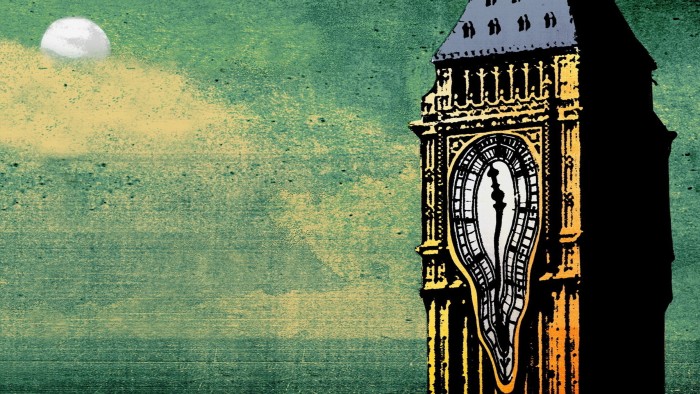Unlock the Editor’s Digest for free
Roula Khalaf, Editor of the FT, selects her favourite stories in this weekly newsletter.
Pass me the Yeats, old boy. “The centre cannot hold”; “all changed, changed utterly”. The victory of Nigel Farage’s Reform UK in last week’s English local elections has divided pundits between the poetic hyperbole of those who see the end of politics as we knew it and the yawning condescension of those who insist things will most likely revert to the mean.
No one can deny the upheaval. Since Brexit, the UK’s politics have become more European. Support for the main parties has withered. There is an unloved government and an unforgiven opposition. Voters have been lured in multiple directions and, above all, Britain has acquired its own populist nationalist force.
The UK has seen multi-party moments before. But at the last general election, combined support for Labour and the Tories was down from 82 per cent in 2017 to just 57 per cent. Last week it was barely above a third. This feels like more than a blip.
It is simply too early to say whether recent results reflect a permanent altering of the political architecture or simply a period of flux as the existing duopoly changes character — new facts or new furniture. But the main parties now have to operate in an alien landscape, where old certainties are being eroded.
One popular trope is that we are witnessing the end of two-party politics. Reform is battering the Conservatives while Labour’s vote frays on the left. But while Farage’s rise threatens the status quo, it is not clear whether Britain’s 100-year duopoly is irreparably shattered or in a state of transition from one pre-eminent force on the right to another.
The UK is certainly seeing realignment on the right (although Reform defies such easy classification) around the politics of immigration and nativism — a comparable pattern to that in many western countries. The Tories had already moved significantly in this respect. Whether they are superseded by Reform, recover or eventually agree some form of pact, one way or another the likely end state is a single dominant entity.
One difference is that, in the words of a senior Labour figure, “the opposition agenda is no longer being set by the official opposition”. For the first time in modern memory, the most energetic opposition movement is largely outside parliament, in county councils and mayoralties and with discourse set on social media. There was municipal opposition to Thatcherism in the 1980s but under the broad Labour umbrella. There are pros and cons to this for Farage. It will be hard to control his new regional legions who have potential to over-reach and embarrass him. Yet this base outside London changes the character of debate and adds to the sense of an outsider, grassroots movement challenging the establishment. For this reason, Reform is already setting the agenda for both main parties.
Then there is the shifting impact of the UK’s first-past-the-post electoral system. This has traditionally acted as a bulwark against insurgents, which is why Reform has backed a change. It stymies new parties: unless they are very effective at local targeting, they need to secure a vote share close to 30 per cent before they enjoy a significant parliamentary breakthrough. However, if a party can breach this high ceiling the system suddenly works to their benefit, delivering hundreds of gains and disproportionately damaging incumbents. Last week, Reform hit those levels.
The existing electoral system still militates against multi-party politics in the long term, though. New parties reflect a gap in the market. Established parties then work to close that gap, but they also change character to do so. Labour could find itself under pressure to protect its left flank, too.
Navigation of this new landscape is further complicated by a larger strategic question. Historically, elections are won by occupying the centre ground. But the centre is shifting. Orthodox economics and progressive social policy are now deemed by many voters to have failed. The realignment on the right springs from this electoral shift. Instead, the new median position is a mixture of social conservatism and more left-leaning, interventionist economics — as evidenced by the wide support for nationalising British Steel.
This change raises two issues. The first is whether there is still the electoral space for two major parties of the traditional mainstream middle, a strong centre left and centre right, or if, as in much of the EU, this space can now support only one major party.
The second is whether either side still wants that liberal centre territory. The Conservatives and Reform have largely abandoned it. If there is room for only one dominant party in this space, Labour (mildly pro-European, politically liberal, fiscally prudent) is currently better placed to occupy it.
But Labour too is chasing those voters Reform is attracting. It identifies as the voice of the underdog not the party of globalisation, and is struggling to hold together a coalition of successful liberals and less well-off workers. It also fears fragmentation of its vote to the left, especially the Greens. A big tent is not necessarily the advantage it was.
It is possible to see routes back to normality (Reform implosion, Labour recovery, Tory revival). But old strategic certainties are dissolving. Part of Reform’s success so far is that it has been quicker to get a feel for the new electoral landscape. Meanwhile, Britain’s big two look like tourists in a foreign country.




